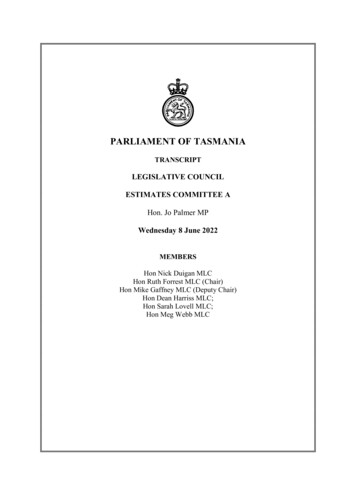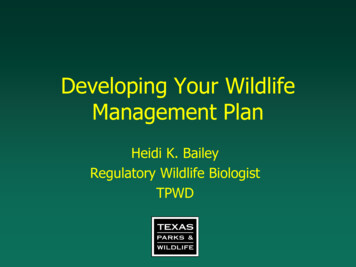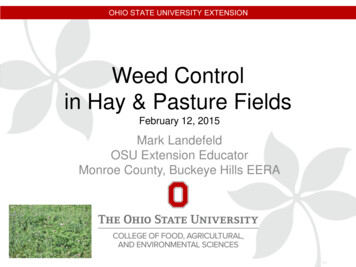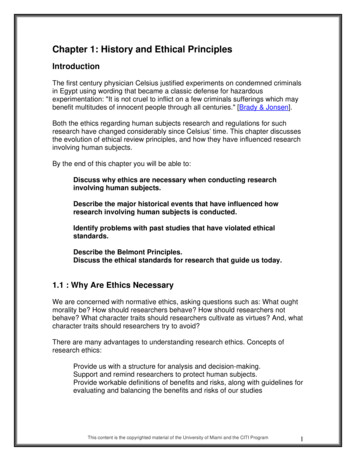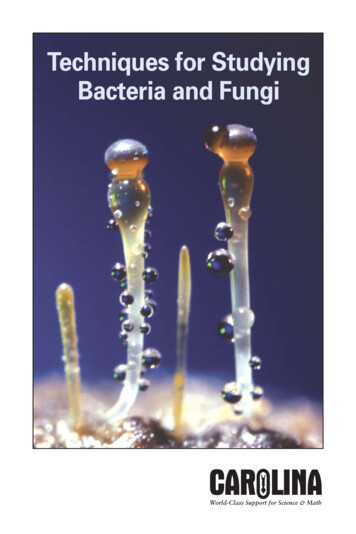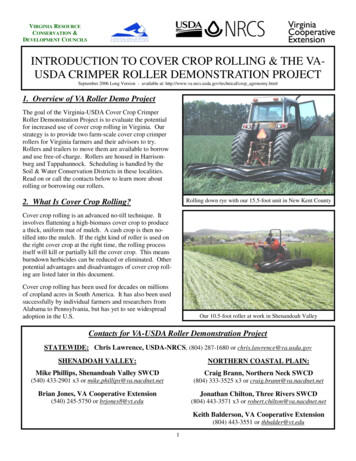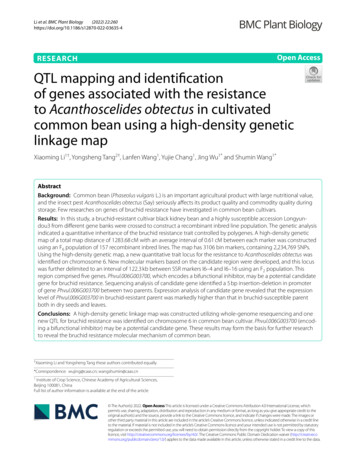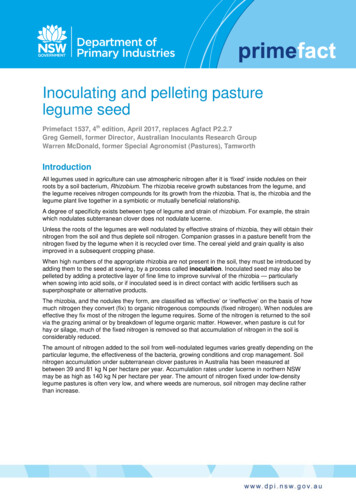
Transcription
Inoculating and pelleting pasturelegume seedPrimefact 1537, 4th edition, April 2017, replaces Agfact P2.2.7Greg Gemell, former Director, Australian Inoculants Research GroupWarren McDonald, former Special Agronomist (Pastures), TamworthIntroductionAll legumes used in agriculture can use atmospheric nitrogen after it is ‘fixed’ inside nodules on theirroots by a soil bacterium, Rhizobium. The rhizobia receive growth substances from the legume, andthe legume receives nitrogen compounds for its growth from the rhizobia. That is, the rhizobia and thelegume plant live together in a symbiotic or mutually beneficial relationship.A degree of specificity exists between type of legume and strain of rhizobium. For example, the strainwhich nodulates subterranean clover does not nodulate lucerne.Unless the roots of the legumes are well nodulated by effective strains of rhizobia, they will obtain theirnitrogen from the soil and thus deplete soil nitrogen. Companion grasses in a pasture benefit from thenitrogen fixed by the legume when it is recycled over time. The cereal yield and grain quality is alsoimproved in a subsequent cropping phase.When high numbers of the appropriate rhizobia are not present in the soil, they must be introduced byadding them to the seed at sowing, by a process called inoculation. Inoculated seed may also bepelleted by adding a protective layer of fine lime to improve survival of the rhizobia — particularlywhen sowing into acid soils, or if inoculated seed is in direct contact with acidic fertilisers such assuperphosphate or alternative products.The rhizobia, and the nodules they form, are classified as ‘effective’ or ‘ineffective’ on the basis of howmuch nitrogen they convert (fix) to organic nitrogenous compounds (fixed nitrogen). When nodules areeffective they fix most of the nitrogen the legume requires. Some of the nitrogen is returned to the soilvia the grazing animal or by breakdown of legume organic matter. However, when pasture is cut forhay or silage, much of the fixed nitrogen is removed so that accumulation of nitrogen in the soil isconsiderably reduced.The amount of nitrogen added to the soil from well-nodulated legumes varies greatly depending on theparticular legume, the effectiveness of the bacteria, growing conditions and crop management. Soilnitrogen accumulation under subterranean clover pastures in Australia has been measured atbetween 39 and 81 kg N per hectare per year. Accumulation rates under lucerne in northern NSWmay be as high as 140 kg N per hectare per year. The amount of nitrogen fixed under low-densitylegume pastures is often very low, and where weeds are numerous, soil nitrogen may decline ratherthan increase.
Inoculating and pelleting pasture legume seedIs inoculation necessary?If there is any doubt as to whether inoculation is necessary, then it is recommended that seed beinoculated. It is inexpensive insurance. When deciding whether to inoculate, consider the following: Is the legume new to that particular paddock?If not new, how many years has it been since well-nodulated plants of the same species or ofa species from the same inoculant group were present?For how many years did they grow there?Are soil moisture, temperature and pH generally suitable for good survival of rhizobia? (Seethe section "Environmental factors affecting the survival of rhizobia".)Some generalisations may be made: Always inoculate legume seed when growing in new areas and for legumes with specificrhizobia requirements, e.g. lotus, lotononis and Kenya clover.Medics and most clover species are likely to be nodulated to some extent by local soilrhizobia. These rhizobia may not be effective in fixing nitrogen. Therefore, all species shouldbe inoculated for new sowings and where a reasonable cover of well-nodulated plants of thesame species (or the same inoculant group) has not been present for the last four years.To compare legumes which have been nodulated by the rhizobia in the inoculant with those whichhave been nodulated by soil rhizobia, leave one short drill strip uninoculated at sowing. Plant growthand nodulation in the inoculated area can then be assessed with those in the uninoculated strip.Figure 1. A good response to the use of inoculant. The dark green vigorous strips were sown withinoculated seed. The yellow to light green strips were from seed which was not inoculated.The cost of inoculation and pelleting is relatively small and the procedure simple. Nodulation failurecan be extremely expensive to overcome because resowing is the only solution for most drylandsituations. Sometimes, direct drilling or oversowing freshly inoculated legume seed into unsatisfactorilynodulated pasture may be necessary.Effective or ineffective nodulation?The nitrogen-fixing ability of nodules may be assessed by their appearance and by the colour andgrowth of the pasture. With newly sown pasture, allow six weeks before assessing nodulation.Nodules are best recovered by carefully digging a plant including a core of soil around its roots andgently washing away the soil to expose the roots. Extra care is needed with lucerne because it is verydifficult to retain nodules unless the plants are young seedlings.2NSW Department of Primary Industries, April 2017
Inoculating and pelleting pasture legume seedFigure 2. Effectively nodulated white clover plants. Note that the large nodules are close to the crowns ofthe plants.Check the nodules growing on the roots for colour, size, position and distribution. Slice open somenodules to check their internal colour. Effective nodules are usually larger, are pink in colour and, ifformed by the inoculum strain, tend to be found near the crown of the plant (see Figure 2). Ineffectivenodules are small and white, are usually more numerous than effective ones, and are scattered overthe root system. This occurs because the ineffective rhizobia are spread through the soil profile.In older nodulated plants some nodules may be green inside or green with pink tips. This indicatesthat the nodule is old or has aged due to stress. The green colour indicates the breakdown product ofthe pink leghaemoglobin, which is essential in the nitrogen fixation process.Nodules with no pigment inside are ineffective, and those with only a small amount of pigment are onlypartially effective, in fixing nitrogen (see Figure 3). Ineffective nodulation in soils of low nitrogen statuscauses plants to be stunted and yellow, with the older leaves yellowing and dying first.A simple test to verify ineffective nodulation is to thoroughly wet the leaves of legumes growing in asmall area with a spray of 0.1% ammonium nitrate (Nitram , i.e. 1.0 gram per litre of water) or urea. Amarked positive growth response within a fortnight, if growing conditions are good, indicates thatnitrogen is limiting growth. No response indicates that factors other than nitrogen are retarding growth.Figure 3. Nodules sliced in half. The ineffective nodules on the right-hand side are small and white.Pigmented pink nodules are effective, while the nodules on the far left are old and breaking down.3NSW Department of Primary Industries, April 2017
Inoculating and pelleting pasture legume seedInoculant preparation and qualityInoculants consist of finely ground peat soil impregnated with a single strain of rhizobia. Selected,highly effective, tested strains of rhizobia are first grown in nutrient broth which is then injected intopackets containing sterilised peat, where the rhizobia multiply. Packets from each batch are tested bythe Australian Inoculants Research Group (AIRG), and only those batches which reach the stringentstandards required are released for sale. Each packet has an expiry date.The establishment of an effective strain of rhizobia depends on the number present on seed atsowing. The minimum number needed, however, is occasionally questioned. The recommendation(from the AIRG) for rhizobia numbers on seed at sowing is 1000 viable rhizobia per seed of mediumsized seeds such as lucerne and subterranean clover, and 500 rhizobia per seed for small seeds suchas white clover. These numbers will not guarantee adequate nodulation under all conditions.In some cases other constraints, e.g. drought, highly acid soils, highly sodic soils etc., will suppressnodulation. However, the recommended standards do represent realistic and attainable numbers ofrhizobia that should ensure adequate nodulation under most conditions of plant establishment andgrowth.Inoculant groupsAmong the rhizobia there is considerable variation. They differ in which legumes they can infect andhow much nitrogen they supply to the plant. Common agricultural legumes have been classified intogroups, each of which requires its own strain. Each group consists of related plants such as medics,but important exceptions include clovers which are divided into a number of groups. It is essential topurchase inoculant of the correct group.Methods of inoculating seedPasture seed can be custom-inoculated by seed retailers, or can be inoculated on the farm just prior tosowing. The advantage of on-farm inoculation is that it can be done closer to sowing time, therebyreducing death of rhizobia before sowing. Death occurs during storage of inoculated seed.The methods of inoculating seed are as follows:Dry inoculation (not recommended)This method involves adding peat inoculum to seed, and mixing. It is not recommended becauseattachment to the seed is poor and much of the inoculant is lost from the seed before and duringsowing. The survival of the rhizobia which remain on the seed is also poorer than for other methods,as the rhizobia have little protection.Slurry inoculationThis is a recommended method of inoculating grain legumes. It is also suitable for pasture seed that isto be sown into moist soil and not in direct contact with fertiliser. (See Table 1.) TMPrepare a 20% SeedStik seed coating adhesive solution. Slowly sprinkle 200 g ofTMSeedStik adhesive into 1 litre of potable hot water ( 70 C) and stir vigorously for about twominutes. Periodically stir the solution for up to 3-4 hours to allow the adhesive to fully dissolve.Cool the solution to less than 30 C. Keep cool until ready to use. Thoroughly stir the solutionprior to use. Use within three days.or 4Prepare a 0.5% methyl cellulose (MC) glue solution by dissolving 5 g methyl cellulose in200 mL hot water (80 C). Then add 800 mL of cold water, and mix. Allow to cool.Mix 250 g of peat inoculant with the glue until evenly dispersed.Pour the mix over:o 25 kg small seed (such as white clover, lucerne); oro 50 kg medium seed (such as subterranean clover); oro 100 kg large seed (such as lablab or centrosema).Mix until seeds are evenly coated. A thoroughly cleaned concrete mixer is suitable.Spread seed in a cool place out of direct sunlight until dry if required.NSW Department of Primary Industries, April 2017
Inoculating and pelleting pasture legume seedTable 1. Inoculation ingredients per kg of seedGlue as SeedStikSeed typeTM20%orPeat inoculantLimeMC (0.5% or 1.5% solution)Small seeds(white clover and lucerne)40mL10g200gMedium seeds(sub clover)20mL5g250gLarge seeds(lablab, centrosema)10mL2.5g125gLime pelletingThe main purpose of lime pelleting is to protect the rhizobia by counteracting mild soil or fertiliseracidity close to the seed. It also ensures better survival of the rhizobia when delays between pelletingand sowing are unavoidable.Lime pelleting is not required when sowing tropical legumes, but may be of benefit in extremely acidsoils, i.e. where pHCa 4.0, or if sowing seed which is in contact with fertiliser. However, Leucaenaand Kenya White Clover should always be lime pelleted.The method for lime pelleting seed is as follows:TM1. Prepare a 20% SeedStik seed coating adhesive solution or 1.5% methyl cellulose gluesolution (15 g methyl cellulose to 1 L of water) — use hot water as described earlier in theslurry inoculation method. After cooling, mix 250 g peat inoculant with the glue until evenlydispersed.2. Pour the mixture over the seed as for slurry inoculation and mix in a rotating drum (concretemixer) until seeds are evenly coated.3. Add the appropriate amount of very fine lime (such as various proprietary products orplasterer’s whiting) in one step to the rotating seed, and roll for 1–3 minutes. Do not usebuilder’s lime (quicklime).4. Allow pelleted seed to dry in a cool place out of direct sunlight.This next step is optional:After pelleting but before drying, overspray the coated seed with a mist spray 1:1 solution of polyvinylacetate (PVA woodwork glue) in water until the surface is damp. Continue rolling until the lime coat isfirm.Do not include this step if the seed/inoculant is not well coated with lime, as some PVA glues havepreservatives that may be harmful to rhizobia.Alternatively, a 1:1 mixture of the original methyl cellulose glue mix in water solution can be used;however, it is inferior to PVA glue. The PVA glue used in the optional final step binds the outside of thepellet which otherwise may be soft and powdery. This will result in pelleted seed flowing more freelywhen drilling.5NSW Department of Primary Industries, April 2017
Inoculating and pelleting pasture legume seedCharacteristics of a good pellet The seed should be evenly coated with the lime.Pellets should be firm enough when dry to withstand light rolling between the fingers.Figure 4. Subterranean clover seed before and after pelleting. The lime coating should be even and firm.Likely causes of poor pelletsPowdery, soft pellets indicate too much lime or uneven mixing, or both. Pasty-looking pellets with theseed surface showing are an indication of too much glue. This may be rectified by adding more lime.Clumps of small seed may also be caused by too much glue or inadequate mixing prior to adding lime.Hard, glossy, smooth pellets indicate too little lime, or too much mixing after adding the lime. Thecoating has a tendency to crack and flake off on drying, especially when handled.A little experience in pelleting seed will help to overcome minor difficulties such as these. Adjustmentsin procedure may be needed for best pellet formation, depending on the machinery and techniqueused.Adding molybdenum at inoculationMolybdenum (Mo) may be added to seed directly at inoculation rather than applying it as a fertiliseradditive at sowing. This is more cost-effective and ensures even distribution of molybdenum in thepaddock.Form of molybdenumThe usual fertiliser form of molybdenum is sodium molybdate, which is 39% pure molybdenum.WARNING: Sodium molybdate is toxic to rhizobia and should not be used. Use either molybdenumtrioxide (66% Mo) or ammonium molybdate (54% Mo).Rate of molybdenum requiredWhen sowing pasture legumes in molybdenum-deficient soils, 50 g Mo is required per hectare, whichis equal to that supplied in 250 kg/ha 0.02% Mo superphosphate. Then, each 4–5 years, 25 g Moshould be applied per hectare as a maintenance dressing (e.g. 125 kg/ha of 0.02% Mosuperphosphate). If using molybdenum trioxide (MoO3), containing 66% Mo, in the pelleting process,the amount of product needed to supply 50 g Mo/ha is 76 g MoO3/ha. Do not apply higher rates ofmolybdenum than those recommended.If sowing a mix of 4 kg/ha subterranean clover and 6 kg/ha lucerne, then 30 g MoO3 should be addedfor every 4 kg of subterranean clover that is inoculated, and 46 g MoO3 should be added for every 6 kgof lucerne seed that is inoculated, a total of 76 g MoO3 for every 10 kg of seed mix – sufficient for onehectare. In this example, a batch of 50 kg of subterranean clover would require the addition of 375 gMoO3. Similarly, a 25 kg batch of lucerne seed would require 192 g MoO3. Difficulties may be6NSW Department of Primary Industries, April 2017
Inoculating and pelleting pasture legume seedexperienced applying sufficient molybdenum trioxide to the seed at low seeding rates, to provide therequired rate of molybdenum per hectare. If this occurs the balance should be added mixed withfertiliser in the traditional way.The quality of molybdenum trioxide can vary, so a check should be made when determining the rate touse.Method Increase the amount of glue solution by 5% to allow for the extra dry material.Mix the inoculant and glue, pour onto seed and mix until seed is evenly moistened.Add the appropriate amount of molybdenum trioxide to the seed proportionally by weight,and mix until evenly coated.Add the normal amount of lime and mix until evenly pelleted.Re-inoculating seedWhere inoculated and pelleted seed (as above) has not been sown within one week of seed pelleting,it is recommended that the treated seed be re-inoculated. Two methods may be used:Dry inoculate and sow immediately. That is, mix peat inoculant with the pelleted seed in the sameproportions as before. Some peat will adhere to the outside of the old lime coating. The rhizobia willnot have the same protection as under the pellet; however, they should receive some benefit from thelime, depending on the pH of the soil.Re-inoculate and pellet. This is the more desirable method, where a lime pellet is seen as essential.This can be carried out normally with the glue/inoculant layer going over the old pellet, then adding thelime as normal, allowing for the extra bulk when estimating quantities. One problem is that the oldpellets can fall apart during the operation. This may be minimised by binding the old pellet first byspraying a very light mist of a 1:1 mixture of methyl cellulose in water. Keep the mix rotating whilespraying and drying.Pre-inoculated seedPre-inoculated seed is available using specialised coating processes. This can extend the potential forthe survival of rhizobia beyond the accepted seven days for traditional lime pelleting. Pre-inoculationgives more flexibility to handle problems such as sowing delays. It is advisable, however, to sow assoon as possible after seed treatment.Processes vary, as does the quality of the product. Recent testing of inoculated seed samplescollected from retail outlets indicated that many samples did not have sufficient numbers of rhizobiapresent per seed for optimal nodulation.Unfortunately, there is no rapid test to assess adequacy of numbers of rhizobia on the seed. If there isany doubt about the survival of rhizobia or the shelf life of a pre-inoculated seed product, contact thesupplying company regarding the need to re-inoculate.When to sowInoculated seed must be kept out of sunlight and as cool as possible, preferably around 15 C, untilready to sow. Slurry-inoculated seed must be sown within 12 hours of inoculation. Lime-pelleted seedshould be sown within 24 hours but, if sowing is unavoidably delayed, store for up to one week at15 C or less. However, aim to sow inoculated seed into moist soil immediately after inoculation inorder to minimise the death of rhizobia.Do not sow inoculated seed in contact with any fertiliser except lime, dolomite or gypsum. If contactcannot be avoided, lime pellet the seed first and do not store it mixed in with the fertiliser — sowimmediately.When sowing lime-pelleted seed, the added lime will increase the bulk of the sowing mixture and alsothe weight. Adjust the combine to sow the correct amount of seed. The increase in weight and sizecan be significant and will depend on the seed size and the efficiency of pelleting. For example,subterranean clover seed may increase in weight by 25%, white clover by 50% and lucerne by 30%.7NSW Department of Primary Industries, April 2017
Inoculating and pelleting pasture legume seedEnvironmental factors affecting the survival of RhizobiaTemperature and moistureRhizobia numbers on seed are highest at the time of inoculation and decline subsequently. Thedecline is dependent on several factors, including: species/strain differencesquality of glue/pelleting materialsstorage conditionstime to sowingenvironmental conditions.High temperatures kill rhizobia. Rhizobia on seed are more sensitive to heat than when in unopenedpackets of peat inoculum. It is important that packets of inoculum are not subjected to hightemperatures for long periods between leaving the manufacturer and their use on the farm.Nearly all inoculants are best stored in a refrigerator. The exceptions are the inoculants for fine stemstylo, centrosema, desmodium and lablab, which should be stored between 20 C and 30 C.Rhizobia in the soil are affected by both soil temperature and moisture. In hot dry soils, rhizobiamortality is greater near the soil surface. The surviving rhizobia at depth produce nodules further downthe roots. The deeper the inoculated seed can be sown, while not affecting seedling establishment,the better the chances are of rhizobia survival.Rhizobia on surface-sown seed and seed drilled shallow into the soil have an even poorer chance ofsurvival and depend on early rain to wash and distribute them into the soil profile. Alternatively, theinoculant can be sprayed below the seed, as is done for some legume crops.Acid soil factorsAcid soil factors which adversely affect plants and rhizobia are: low pHlow calcium (Ca) and phosphorus (P)high levels of aluminium (Al) or manganese (Mn).A measure of soil pH is an initial indicator of potential adverse effects on plants and nitrogen fixation.As soil pH falls, calcium, phosphorus and molybdenum become less available for plant growth,nodulation and nitrogen fixation. If in doubt about soil acidity in your situation, consult a localagricultural advisor.In general, rhizobia are more tolerant of these factors than are the plants. When sowing inoculatedseed into acid soils, the seed should be lime pelleted. If the soil pHCa is below 5.0, it is necessary toalso sow with additional agricultural lime. The amount of lime will vary according to the soil pH and themethod, such as whether the seed is broadcast or drilled. A local agricultural advisor should be able torecommend suitable rates for the particular situation.Nitrogen fixation is very dependent on phosphorus and molybdenum. In deficient soils, phosphorusshould be applied at sowing, while molybdenum may be applied with the superphosphate orincorporated into the lime pellet.Compatibility of Rhizobia with agrochemicalsRhizobia are sensitive organisms, and many fertilisers, fungicides, insecticides and herbicides canharm them. Other chemicals may do only slight harm or have no effect. There are three major factorsto be considered when attempting to predict any unfavourable interactions:1. Are the chemicals acid in solution? Most rhizobia are sensitive to solutions of pHCa valuesbelow 5.0 (and above 8.0).2. Do the preparations contain toxic chemicals? Metals such as mercury, copper and zinc areharmful; the effect of other active ingredients may be difficult to predict.3. Is there prolonged direct contact between the substance and inoculated seed? If direct contactis avoided, or is only brief, the effect may be minimised.8NSW Department of Primary Industries, April 2017
Inoculating and pelleting pasture legume seedSome pesticides are registered to treat pasture legume seed. Below we mention some registeredactive ingredients (ais) for use with inoculated pasture legume seed. Not all products with the listed aisare registered for pasture legume seed. Check the product label to see whether the use pattern isregistered and follow all label directions fully.Specific examples of interactions with inoculated seed include:Fertilisers Superphosphate and related products, because they are very acid, are toxic to rhizobia ifin direct contact. Either the chemical’s acidity must be reduced by mixing with agriculturallime, or the seed must be lime pelleted. Even if lime pelleted, the time the seed is incontact with superphosphate should be as short as possible.Gypsum can be mixed with inoculated seedStarter fertilisers used at low rates for pasture establishment, such as 45 kg/hamonoammonium phosphate, can be sown with lime-pelleted seed (no more than 20 kgN/ha with the seed)Molybdenum as used for seed treatment can be toxic if the wrong form is used.Molybdenum trioxide and ammonium molybdate are compatible; however, sodiummolybdate is toxic to rhizobia.FungicidesTests have shown that Metalaxyl and Metalaxyl-M, when applied to inoculated seed, contribute to areduction in the number of rhizobia, and therefore should be used strictly in accordance with themanufacturer’s instructions.Insecticides Bendiocarb and permethrin, used to protect seed from ants, are safe (although limitedtrials indicate that there may be some reduction in nodulation)Dimethoate can harm rhizobiaImidacloprid is safe to rhizobia provided treated seed is sown into moist soil within oneday of treatment for subterranean clover and murex medic, and within six days oftreatment for other species (e.g. white clover, serradella, lucerne and barrel medic).Follow label instructions carefully.HerbicidesRhizobia are relatively tolerant to herbicides at concentrations recommended for field use. Because ofthe differences in susceptibility between the host and their rhizobia, it is difficult to make accurateassessments.When the toxicity of a particular herbicide is unknown, keep it separated from inoculated seed.Inoculation failureWhere inoculation has failed, keep in mind the environmental and agrochemical compatibility factorsoutlined above when looking for the reason.Attempts at introducing fresh inoculum into a failed paddock have had varied success, because highnumbers of rhizobia are needed close to the seed and it is difficult to deliver the required number in aneconomical and practical way.Usually the best method is to resow the pasture legume component of the mixture with freshlyinoculated and pelleted seed. This may involve waiting until the following year for the optimum sowingtime. When perennials are involved, greater flexibility exists. Low quantities of nitrogenous fertiliser(e.g. less than 20 kg N/ha) may assist in maintaining the health and vigour of the plant until nodulationoccurs. Consult an agricultural advisor for further information.9NSW Department of Primary Industries, April 2017
Inoculating and pelleting pasture legume seedMore informationFor more information contact Local Land Services, seed suppliers or your preferred agriculturaladvisor. For updates go to iewed April 2017. Based on Agfact P2.2.7 Inoculating and pelleting pasture legume seed, 4edition, July 2005 by Greg Gemell and Warren McDonald. The authors thank the following people fortheir technical assistance: Dr D Herridge, formerly NSW DPI, Tamworth; Mr R Gault, CSIRO,Canberra; Dr J Evans, NSW DPI, Wagga Wagga; Dr R Date, CSIRO, Brisbane, Queensland; and JSlattery, formerly of Department of Natural Resources and Environment, Rutherglen, Victoria.Photos: Figure 1 D. Herridge, Figures 2 and 3 R. Roughly, Figure 4 W. McDonaldDisclaimerTrade namesThe product trade names in this publication are supplied on the understanding that no preference between equivalent products is intended andthat the inclusion of a product name does not imply endorsement by the NSW Department of Primary Industries over any equivalent product fromanother manufacturer.WarningAlways read the labelUsers of agricultural or veterinary chemical products must always read the label and any permit, before using the product, and strictly comply withthe directions on the label and the conditions of any permit. Users are not absolved from compliance with the directions on the label or theconditions of the permit by reason of any statement made or not made in this publication.Pasture improvement cautionsPasture improvement may be associated with an increase in the incidence of certain livestock health disorders. Livestock and production lossesfrom some disorders are possible. Management may need to be modified to minimise risk. Consult your veterinarian or adviser when planningpasture improvement.The Native Vegetation Act 2003 restricts some pasture improvement practices where existing pasture contains native species. Inquire through theNSW Office of Environment and Heritage for further details. State of New South Wales through the Department of Industry, Skills and Regional Development, 2005. You may copy, distribute and otherwisefreely deal with this publication for any purpose, provided that you attribute the NSW Department of Primary Industries as the owner.Disclaimer: The information contained in this publication is based on knowledge and understanding at the time of writing (April 2017). However,because of advances in knowledge, users are reminded of the need to ensure that information upon which they rely is up to date and to checkcurrency of the information with the appropriate officer of the Department of Primary Industries or the user’s independent advisor.ISSN 1832 666810NSW Department of Primary Industries, April 2017
Pasture seed can be custom-inoculated by seed retailers, or can be inoculated on the farm just prior to sowing. The advantage of on-farm inoculation is that it can be done closer to sowing time, thereby reducing death of rhizobia before sowing. Death occurs during storage of inoculated seed. The methods of inoculating seed are as follows:
